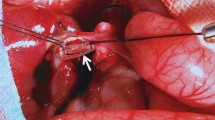Summary
In spite of many attempts to produce an experimental model for studying the pathogenesis and the pathophysiology of portal hypertension and esophageal varices, satisfactory results have not been reported. Since most attempts involved multiple operations or complicated surgical maneuvers to achieve portal hypertension, experimental animals could not survive easily.
This new procedure requires only a simple operation, so experimental animal survival is high. The portal venous pressure can be raised immediately by increasing intrahepatic vascular resistance. This is done by wrapping and compressing the whole liver with polypropylene mesh, which also prevents the development of hepatopetal collaterals. The experimental production of portal hypertension in fifteen dogs resulted in only one death. The remaining fourteen dogs were in good condition for nine weeks after the operation and were mainteining elevated ranges of portal pressure with an average of 326 mmH2O. Varying degrees of esophageal venous dilatation were evident. Based on the results, this newly developed method seems to be useful for studying the pathophysiology of the portal hypertension and esophageal varices.
Similar content being viewed by others
References
Yamana H, et al: Direct operation for esophageal varices. Jpn J Gastroent Surg l2: 122, 1979
Rousselot LM, et al: Experimental production of congestive splenomegaly. Proc Soc Exper Biol Med 40: 705, 1939
Whipple AO: The problem of portal hypertension in relation to the hepatosplenopathies. Ann Surg 122: 449, 1945
Stone PW, et al: A method for experimental production of gradual occlusion of the portal vein. Proc Soc Exper Biol Med 72: 255, 1949
Best CH, et al: Liver damage produced by feeding alcohol or sugar and its prevention by choline. Br Med J 2: 001, 1949
Hoffbauer FW, et al: Factors influencing pressure in the portal veins as studied in the intact animal. Gastroenterology 16: 194, 1950
Child CG, et al: Sudden and complete occlusion of the portal vein in the macaca mulatta monkey. Ann Surg 132:475, 1950
Douglass TC, et al: Attempts at the experimental production of portal hypertension. Arch Surg 62: 785, 1951
Morris AN, et al: Chronic portal vein occlusion and portal hypertension in the dog. Surgery 30: 768, 1951
Wiles GE jr, et al: The experimental production of portal hypertension. Ann Surg 136: 811, 1952
Schilling JA, et al: Experimental hepatic-portal arteriovenous anastomoses. Surg Gynecol Obstet 90: 473, 1950
Volwiler W, et al: Chronic portal vein obstruction in dogs from silica cirrhosis. Gastroenterology 24: 405, 1953
Tamiya T, et al: Esophageal varices produced experimentally in the dog. Surg Gynecol Obstet 90: 147, 1960
Author information
Authors and Affiliations
Rights and permissions
About this article
Cite this article
Yamana, H., Yatsuka, K. & Kakegawa, T. Experimental production of portal hypertension in dogs by a whole liver compression. Gastroenterol Jpn 18, 119–127 (1983). https://doi.org/10.1007/BF02774686
Received:
Accepted:
Issue Date:
DOI: https://doi.org/10.1007/BF02774686




